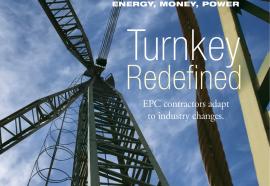Federal Energy Regulatory Commission (FERC)
Open Access on Trial
The old rules don’t always fit with new commercial realities.
To encourage billions of dollars of investment into America’s transmission grid over the next several decades, the Federal Energy Regulatory Commission (FERC) is restructuring its regulatory policies to bring market-based solutions into the framework for planning, construction, and operation of new transmission lines. The recent Order 1000 is the most dramatic example of this effort. But as FERC has learned before, one set of rules doesn’t serve the financial and commercial needs of all market participants.
Transmission Rate Incentives
Submitted by meacott on Tue, 2011-11-08 17:03FERC’s move might appear calculated to send a message to the power industry.
The Federal Energy Regulatory Commission (FERC) in mid-October granted a trimmed-down set of rate incentives for the proposed $1.6 billion RITELine transmission line project.
Transmission Tug-of-War
From EPAct to Order 1000, siting authority continues evolving.
Six years after Congress granted FERC “backstop” siting authority for electric transmission projects in the Energy Policy Act of 2005, the regulatory landscape is still evolving as a result of federal court decisions and new FERC orders. But despite a lack of certainty at the federal level, project sponsors have filed numerous applications at the state level for new transmission projects. Can these projects proceed without greater certainty at FERC?
Bench Report: Top Ten Legal Decisions of 2011
1. ‘Policy’ Guides the Grid; 2. Carbon Not a Nuisance (Yet); 3. Gigabucks for Negawatts; 4. A MOPR, Not a NOPR; 5. Ramp Up the Frequency; 6. Cap-and-Trade Still Lives; 7. Cyber Insecurity; 8. Korridor Killer; 9. The Burden Not Shared; 10. Ozone Can Wait.
Achieving Interoperability
The smart grid requires utilities and regulators to assert leadership.
Adopting an interoperable framework for the smart grid isn’t just a question of technology standardization. It’s also about navigating the legal, regulatory, and business factors that affect technology implementation. Making the smart grid work will require utilities and regulators to assert leadership.
Technology for the Masses
The consumer-centric smart grid and its challenge for regulators.
Federal and state regulators play a critical role in the evolution of the smart grid. Lawmakers face a host of questions, from deciding who owns consumer data and how it can be used, to defining a new range of regulated and unregulated utility services and applications. How much regulation will be needed to manage the transformation to a smart grid? And how much regulation will be too much?
Cap-Ex Conundrum
Does slow and steady still win the race?
When a capital-intensive industry enters an asset-building cycle, many companies will operate in the red for a few years or more. That’s not necessarily a bad thing, as cap-ex investments represent growth for shareholders. The devil is in the details, however, and companies facing a large slug of environmental compliance investments might produce disappointing returns over the next few years.
Vendor Neutral
(August 2011) Shaw Group completes 500 MW combined cycle plant; Pattern Energy begins building Spring Valley wind farm; AEP, Duke and TVA team up on interstate transmission line; AEP and MidAmerican contract for Texas transmission projects; Alliant contracts Open Systems International for volt-VAR control system; Alstom buys into AWS Ocean Energy; Siemens acquires shares in PV manufacturer Semprius; Lockheed Martin introduces cyber security system; plus contracts and announcements involving Elster, Itron, Suzlon, Solon, Sensus, Westinghouse Electric, Morgan Lewis and others.
The NOPR Was Late
But transmission planning, as we know it, may never be the same.
The recent landmark ruling on transmission planning cost allocation, known as “Order 1000,” and issued by the U.S. Federal Energy Regulatory Commission in late July 2011, could well produce an unintended side effect — the formation of regional compacts among states to identify needs and plan for development of new power plant projects.









